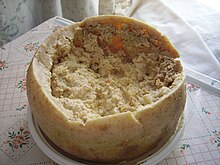집먼지 미트
House dust mite집먼지진드기(HDM, 또는 단순한 먼지진드기)는 주거지의 먼지와 관련하여 발견되는 진드기이다.[3] 그들은 알레르기를 일으키는 것으로 알려져 있다.
생물학
종
현재 알려진 종은 다음과 같다.[4]
- 피부염포고이데스파리나에(미국산 먼지 진드기)
- 피부염포고아데스 프테로니스시누스(유럽의 집먼지 미트)
- 살피노파고데스 에반시
- 피부염포고아데스미생물
- 살피노파고이데스 할테로필루스
- 시보니
- 신열대성피부염
- 피부염포고이데스알렉스파이니
- 피부염포고아데스아니소포다
- 피부염고아데스치로비
- 피부염포고이데스데네이
- 르완다아목
- 피부염포고이데스 스크레미터스키
- 피부염포고이데스스크메테스키이스키
- 심플렉스
- 유로글리푸스 메이네이 (메이네 집 먼지 진드기)
- 유로글리푸스 롱기오르
- 허스티아 도미콜라
- 말라요글리푸스 카르멜리투스
- 말라요글리푸스 중간자
- 피로글리푸스 아프리카누스
- 스투르노파고이데스브라질렌시스
- 블로미아열대
분류학
특성.
집먼지진드기는 크기가 매우 작고 반투명한 몸체 때문에 도움을 받지 못하는 눈에는 거의 보이지 않는다.[5] 일반적인 집먼지 진드기는 길이가 0.2–0.3 mm이다.[6] 그 집 먼지 진드기의 몸체에는 줄무늬가 있는 큐티클이 있다.
집먼지 미트 페칼 펠릿의 범위는 10~40µm이다.[1]
다이어트
그들은 인간과 다른 동물들의 피부 조각과 어떤 곰팡이를 먹고 산다. 시험관내에서는 가정에서 흔히 볼 수 있는 16종의 시험종에서 피부염포고아과 균류 식품 선택이 알터타리아 교배종, 클래도스포륨 스파이로스페르모룸, 월레미아 세비로 관찰되었으며, 페니실륨 크리소게넘, 아스페르길루스 버시콜로르,[7] 스타키보트리스를 싫어했다.
포식자
먼지 진드기의 포식자는 다른 알레르기성 진드기(체일레티엘라), 은어, 가성 진드기 등이다.[8]
재생산
집먼지 더미의 평균 수명은 65-100일이다.[9] 짝짓기된 암컷 집 먼지 진드기는 70일까지 살 수 있으며, 마지막 5주 동안 60~100개의 알을 낳는다. 10주간의 수명 동안, 집먼지 진드기는 약 2,000개의 배설물 입자와 심지어 부분적으로 소화된 효소 덮개 먼지 입자를 더 많이 생성할 것이다.
분배
먼지 진드기는 전 세계적으로 발견되지만 습한 지역에서 더 흔하다.[10] 블로미아 열대성 종은 전형적으로 열대 지방이나 아열대 지방에서만 발견된다.[11] 검출 가능한 먼지 진드기 알레르겐은 조사 대상 미국 가정 중 약 84%의 침대에서 발견되었다.[12] 유럽에서는 조사 대상 주택의 68%에서 검출 가능한 더 p 1 또는 더 f 1 알레르겐이 발견되었다.[13]
건강 문제
알레르기
먼지진드기에 있는 주요 알레르기 유발물질인 트로포미오신도 조개 알레르기의 원인이다.[14][15]
구강 진드기 아나필락시스
spp.는 밀가루에서 발견되면 경구 진드기 아나필락시스(AKA pancake syndrome)를 일으킬 수 있다.[16][17]
참고 항목
참조
- ^ a b "House dust mite excrements/ faeces HDM excrements". Citeq Biologics. 1 October 2018.
- ^ "Best Fabrics to Exclude Dust Mites". HouseDustMite.com. Retrieved 24 January 2019.
- ^ Denmark, H. A.; Cromroy, H. L. (April 2017) [October 1998]. "House dust mites—Dermatophagoides spp". Featured Creatures. Department of Entomology & Nemotology, University of Florida, and Florida Department of Agriculture and Consumer Services, Division of Plant Industry. EENY-59. Originally published as DPI Entomology Circular 314.CS1 maint: 포스트스크립트(링크)
- ^ "House Dust Mites: Ecology, Biology, Prevalence, Epidemiology and Elimination". Retrieved 25 May 2021.
- ^ "Why study the major cause of allergy, the house dust mite?". HouseDustMite.com. Retrieved 24 January 2019.
- ^ "The House Dust Mite: Dermatophagoides pteronyssinus". MicrobiologyBytes. 2007. Archived from the original on 16 May 2007. Retrieved 24 January 2019.. 비디오가 사라졌음을 참고하십시오.
- ^ Naegele, Alexandre; Reboux, Gabriel; Scherer, Emeline; Roussel, Sandrine; Millon, Laurence (1 April 2013). "Fungal food choices of Dermatophagoides farinae affect indoor fungi selection and dispersal". International Journal of Environmental Health Research. 23 (2): 91–95. doi:10.1080/09603123.2012.699029. ISSN 0960-3123. PMID 22774849. S2CID 46508627.
- ^ "House dust mites: Agents of allergy". acari.be. Archived from the original on 29 December 2010. Retrieved 24 January 2019.
- ^ Miller, J. D. (23 June 2018). "The Role of Dust Mites in Allergy". Clinic Rev Allerg Immunol. 57 (3): 312–329. doi:10.1007/s12016-018-8693-0. ISSN 1559-0267. PMID 29936683. S2CID 49406343.
- ^ Madden, Anne A.; Barberán, Albert; Bertone, Matthew A.; Menninger, Holly L.; Dunn, Robert R.; Fierer, Noah (2016). "The diversity of arthropods in homes across the United States as determined by environmental DNA analyses". Molecular Ecology. 25 (24): 6214–6224. doi:10.1111/mec.13900. ISSN 1365-294X. PMID 27801965. S2CID 22325949. Lay summary.
- ^ Dutra, Moisés S; Roncada, Cristian; da Silva, Guilherme L; Ferla, Noeli J; Pitrez, Paulo M (2018-05-04). "Mite Fauna Assessment in Houses of Two distinct Socioeconomic Groups From Southern Brazil". Journal of Medical Entomology. 55 (3): 620–625. doi:10.1093/jme/tjx239. ISSN 0022-2585. PMID 29281052.
- ^ Arbes, Samuel J.; Cohn, Richard D.; Yin, Ming; Muilenberg, Michael L.; Burge, Harriet A.; Friedman, Warren; Zeldin, Darryl C. (2003-02-01). "House dust mite allergen in US beds: Results from the first national survey of lead and allergens in housing". Journal of Allergy and Clinical Immunology. 111 (2): 408–414. doi:10.1067/mai.2003.16. PMID 12589364.
- ^ Luczynska, Christina; Svanes, Cecilie; Dahlman-Hoglund, Anna; Ponzio, Michela; Villani, Simona; Soon, Argo; Olivieri, Mario; Chinn, Susan; Sunyer, Jordi (2006-09-01). "Distribution and determinants of house dust mite allergens in Europe: The European Community Respiratory Health Survey II". Journal of Allergy and Clinical Immunology. 118 (3): 682–690. doi:10.1016/j.jaci.2006.04.060. ISSN 0091-6749. PMID 16950288.
- ^ Lopata AL, Kleine-Tebbe J, Kamath SD (November 2016). "Allergens and molecular diagnostics of shellfish allergy: Part 22 of the Series Molecular Allergology". Allergo J Int. 25 (7): 210–18. doi:10.1007/s40629-016-0124-2. PMC 5306157. PMID 28239537.
- ^ Prester L (August 2016). "Seafood Allergy, Toxicity, and Intolerance: A Review". J Am Coll Nutr. 35 (3): 271–83. doi:10.1080/07315724.2015.1014120. PMID 26252073. S2CID 1154235.
- ^ Barrera, OM; Murgas, IL; Bermúdez, S; Miranda, RJ (June 2015). "[Oral anaphylaxis by ingestion of mite contaminated food in Panama City, 2011-2014]". Revista Alergia Mexico. 62 (2): 112–7. doi:10.29262/ram.v62i2.71. PMID 25958374.
- ^ Sánchez-Borges, Mario; Suárez-Chacon, Raúl; Capriles-Hulett, Arnaldo; Caballero-Fonseca, Fernan; Iraola, Victor; Fernández-Caldas, Enrique (1 January 2009). "Pancake Syndrome (Oral Mite Anaphylaxis)". World Allergy Organization Journal. 2 (5): 91–6. doi:10.1186/1939-4551-2-5-91. ISSN 1939-4551. PMC 3651046. PMID 23283016.
외부 링크
| 위키미디어 커먼스는 피부염고아데스 관련 매체를 보유하고 있다. |
- 미국 천식 알레르기 재단 웹사이트의 먼지 진드기 알레르기





